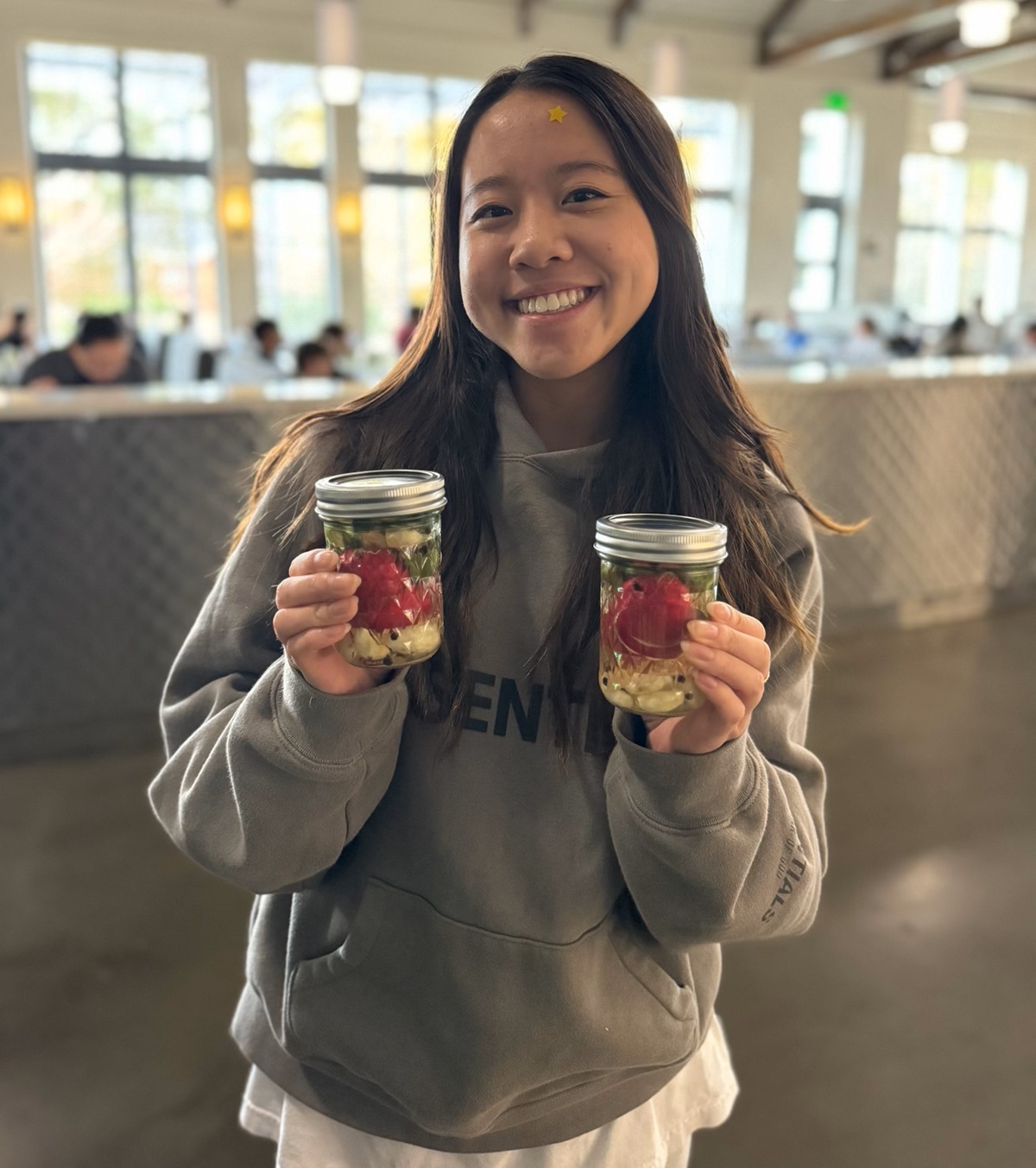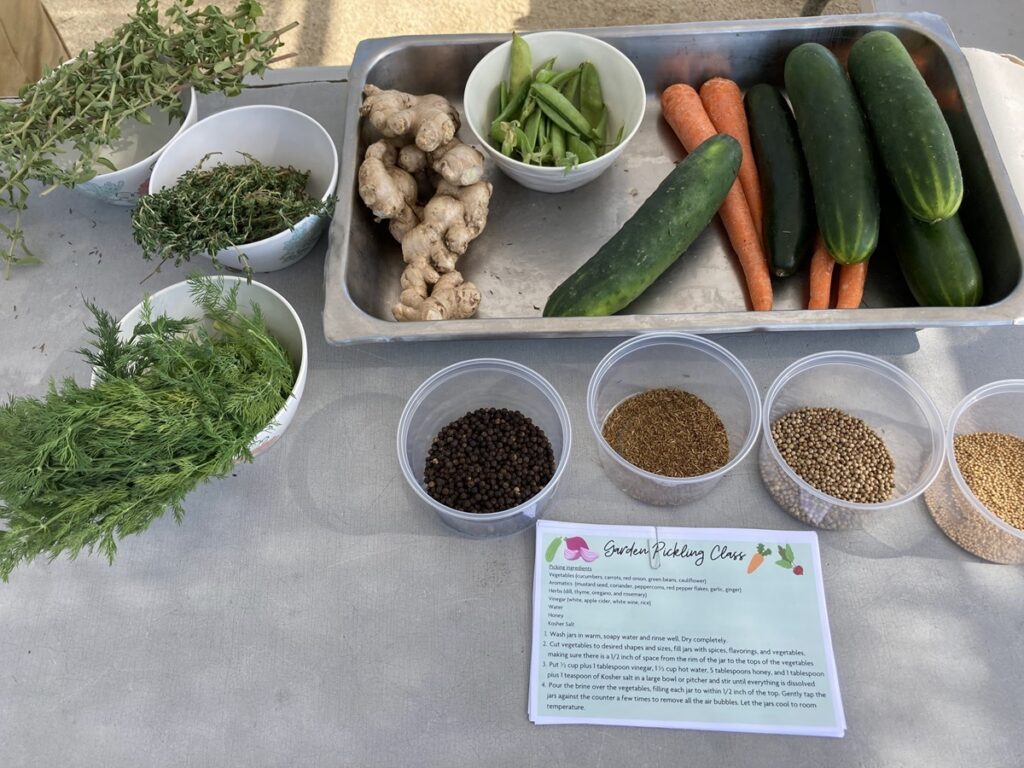Have Brine, Will Travel: Pickling Pop-ups with the Fellows

Pickle pride at Oxford College at Emory University
As Bon Appétit Fellows, part of our job is to travel to the different campuses we serve and collaborate with our culinary teams, along with university staff and student clubs, to engage students and inspire the next generation of sustainable food lovers and advocates. It’s always fun to get hands-on, of course, which is why we designed our quick pickling demo. Following food safety best practices, we show students how to make refrigerator pickles, using fun, customizable recipes that they can make in their residence hall to preserve local, seasonal produce and turn it into a crunchy, salty, healthy, and sustainable snack.
During these winter months especially, a jar of pickles from the fall harvest can be just the thing to brighten up a dish with a hit of perky acidity and crunch. Plus, pickling (either via the quick refrigerator method or the shelf-stable one – which we don’t demo, given the food safety variables involved in this type of food preservation) stops food waste in its tracks by preserving seasonally abundant produce. Anyone who grows vegetables knows what zucchini overload is like. Don’t toss it, pickle it!
As Fellows, we’ve traveled all over the country and showed hundreds of students how to make their vegetables last a little longer – even from their dorm rooms. We show the students how to make a basic pickle brine, and how to customize their fridge pickles using different flavor combinations of vegetables, herbs, spices, and aromatics.
From Garden to Jar
On the West Coast, on the first-ever Fellows visit to Soka University, I held a pickling class in the Soka Instructional Garden for about 15 students who were involved with the garden and/or eager to learn more about cooking. Several students in charge of a garden plot harvested red onions, carrots, snap peas, and beets for us to use. The Bon Appétit team provided us with cucumbers, ginger, garlic, herbs like dill, marjoram, and thyme, spices like coriander, mustard seeds, and peppercorns, and the ingredients needed to make a quick pickle brine – salt, sugar, hot water, and vinegar. The vinegar is essential to the process, as it helps to transform the flavor and texture of the vegetables into the crunchy, acidic pickles we love and acts as a short-term preservative.
Everyone got creative with their flavors and ingredient combinations, adding ginger to pickled beet, adding onion tops for extra flavor in the jar, and combining snap peas with marjoram and thyme. I also handed out recipe cards, so students could easily try quick pickling on their own.
This class fell on Stop Food Waste Day, so it was a perfect opportunity to chat about Bon Appetit’s food waste and local purchasing policies. Quick pickling is an important culinary technique used by our chefs to support our food waste reduction goals in terms of stem-to-root cooking and other food preservation methods to make sure food doesn’t get wasted in the first place.

Getting ready for a pickling popup at Soka University
The Latest Lunchtime Craze
Last fall, Midwest Fellow Elise Kulers hosted a pickling pop-up in the cafe at Oxford College at Emory University. She went through 70 jars (!!!) during lunchtime with students, professors, and Bon Appétit chefs all making pickle variations. Some people came back as many as four times to make jars to bring home for different family members. Hot peppers (and members of the cayenne family) from the Oxford farm called Red Rocket were a hit, along with assorted root vegetables and the Southern staple and pickling stalwart okra. Community members were also excited about pickling whole garlic cloves. For some students, it was a revelation; “I’ve never pickled before,” said one. “We should do this every day during lunch,” said another.
On the East Coast, 100 Vassar students made jars of pickles using freshly harvested produce from Poughkeepsie Farm Project with Fellow Elise Dudley. During the lunch period, attendees filled jars with produce, learned about the Poughkeepsie Farm Project, and took home recipe cards. Students picked from various ingredients like beets, cabbage, green tomatoes, daikon radishes, watermelon radishes, onions, and garlic cloves. They added peppercorns, red pepper flakes, and other whole spices before filling their jars with brine to play with flavor combinations. Community members and Elise discussed how to fill jars in a way that shows off the beauty of the vegetables, along with the role of fermentation and pickling in preventing waste.
For many students and lovers of local food, quick pickles are an ideal introduction into the exciting and practical world of sustainable food preservation!